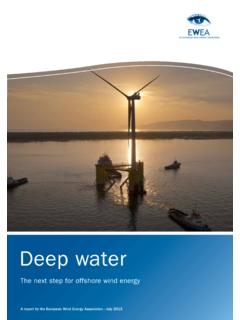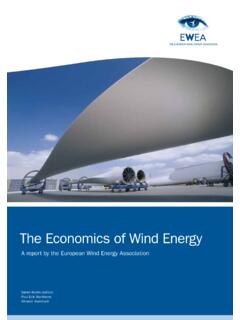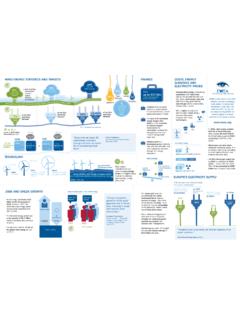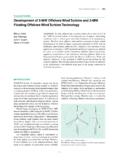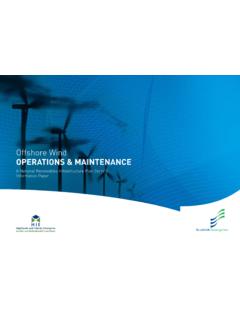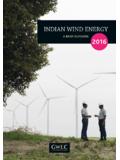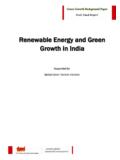Transcription of Wind Energy The Facts: Offshore - EWEA
1 wind Energy The Facts: Offshore J r me Guillet 28 November 2011 . Project Finance for Offshore wind Contents 1. Project finance for Offshore wind the theory 2. The early deals 3. The market(s) today 4. What's next? 2. Green Giraffe Energy Bankers is a specialist advisory boutique focused on renewable Energy We have an unparalleled track record in successfully closing deals for our clients 18 professionals in London (UK), Utrecht (Netherlands) and Paris (France). project & structured finance, M&A, legal & contracting expertise priority given to a limited number of clients, based on long term relationships Advisor to C-Power to raise project finance debt 325 MW. Belgium 2010. Advisor to WindMW to raise project finance debt 288 MW. Germany 2011. 3. Green Giraffe 1.
2 Project finance for Offshore wind the theory 4. Two fundamental principles No recourse No upside Recourse to investors is contractually limited Lenders receive a fixed remuneration Lenders rely on project revenues only Lenders do not benefit from better performance Capital intensive projects requiring long term financing Low single digits margins vs high leverage Lenders need LT operational performance Risks to be commensurate to remuneration Lenders need to make sure that the project works on a Lenders need risks to be measurable and to have probabilities of standalone basis, with no third party commitments than those occurring in the low single digits for investment to make sense. made at financial close. Such commitments must be realistic, Risks which are (seen as) well understood are thus easier to bear credible and durable, both contractually and economically Project finance lenders will usually have priority access to cash- This typically entails very detailed contractual frameworks and flows (after certain pre-agreed operation expenses necessary to extensive due diligence keep the project running) and security on all assets, contracts and equity of the project 5.
3 An overriding focus on the contractual package PF transactions are always heavily contracted Equity Debt Major contracts include: Sponsor(s) Lenders permits, licenses, authorisations, etc Dividends Debt Service O&M Electricity Project construction/supply contracts Company Payments Support/. Warranties electricity sales contracts (and, if Turbine Power Marine construction applicable, green certificates Supply Construction Electricity Purchaser Deliveries contracts) Contracts Electrical Works Licenses Obligation to buy renewable O&M contracts Certification that electricity Foundations production is renewable Tariff for such financing documents Regulatory electricity Construction Authorities permits wind and Offshore wind in particular are quintessential examples of comprehensive contractual structures 6.
4 Offshore wind - debt sizing principles Revenue side constraint Capital expenditure constraint Total capital expenditures C Turbines O. N Foundations S Equity and T Electricals quasi equity R. U. C Installation T Insurance I. O. Construction engineering N. Development costs Senior Debt F MLA and due diligence costs I. N Debt fees (arranging + commitment). A. N Interest during construction C. E DSRA. Offshore DSCR constraint: with p50 or with p90 Debt : Equity < 70:30. No or very limited price risk on revenue side Limited tolerance for junior debt mechanisms Net availability number in the 90-92% range Limited tolerance for taking into account pre- Conservative O&M cost assumptions completion revenues Strong requirement for equity to be paid upfront 7. Offshore wind risk analysis (1).
5 Risk are different in each project phase Development phase Construction phase Operational phase (never borne by banks) (can be borne by banks) (typically borne by banks). No project! Delay and cost overruns Lost revenue No permits Scope gaps Lower availability No tariff / PPA Contractor delays Higher O&M cost No contracts Adverse weather Lower prices Not enough money Accidents Less wind Mitigation cascade Project management Project coordination Project management Detailed planning Solid contracts (LDs) Long term O&M contract Committed sponsors Contingency budget Turbine manufacturer commitment Insurance Insurance 8. Offshore wind risk analysis (2). Offshore wind adds new risks to traditional PF risks Regulatory / political risk no to permitting risk, yes to (some) regulatory change risk Price / market risk no to volume risk, yes to (some) price risk Counterparty risk increasing attention as projects grow in size Technology risk core risk, but banks have shown willingness to bank new turbines wind risk easier Offshore than onshore; wake effect is key worry Construction risk still the toughest risk (multicontracting), not done in London market yet Operating risk taken on the basis of long term O&M agreements with WTG manufacturers An oval foundation after it A crane collapsed in the sank during transport to site marshalling harbor Offshore wind can still look quite scary 9.
6 Green Giraffe 2. The early deals 10. The early deals (1). 4 deals just before and after the financial crisis Q7 princesamalia (2006, the Netherlands, 120 MW, Vestas V80, EUR 219 M financing). The very first deal set a number of precedents (debt sizing principles, multi-contract construction risk taken via heavy due diligence and contingent funding, 10-year O&M package). 3 MLAs, 3 additional banks, plus key support from EKF. C-Power phase 1 (2007, Belgium, 30 MW, Repower 5M, EUR 126 M financing). Consolidation deal a more aggressive version the Q7 structure (construction risk, longer tenor thanks to the longer term support framework, some merchant risk). Confirms that new turbines, even very large ones, are bankable 1 MLA, 3 additional banks, no multilateral Belwind (2009, Belgium, 165 MW, Vestas V90, EUR 544 M financing).
7 First deal post-financial crisis allowed to confirm that the early structures were sound (construction risk, some merchant risk) while increasing the size thanks to heavy multilateral involvement 3 MLAs, EIB and EKF, no syndication heralded the club deal period Boreas (2009, UK, 194 MW Offshore , Siemens , GBP 340 M financing). First UK deal, with a large number of banks (14 altogether). No construction risk, but funding under the UK ROC regime, with some merchant risk 11. The early deals (2). Pioneers precedent-setting, but with a small number of players Successful structures and really non recourse! DD + Contingent mechanism structure to bear construction risk validated in subsequent deals Construction risk with multi-contract structure validated and repeated Repeated with several different turbines, sponsors and regulatory regimes All early projects built within agreed budget and timetable, and now operating to full satisfaction A fairly small number of players involved Only a small number of institutions actually took construction risk Heavy reliance on a small number of multilaterals (EKF, EIB).
8 The same advisors and people in almost every deal A difficult market context No syndication market for what are fairly large deals thus a need for *everybody* on each deal Lack of precedents at a time banks were retreating to favored clients and familiar risks 12. Green Giraffe 3. The market(s) today 13. Market segments There are at least two semi-separate markets The UK market Only one deal closed (without construction risk) and several delayed by over 2 years Large gap between expectations of investors and what the market was willing to do Bad image generated by persistent, if relatively minor, technical glitches (ie grouting issues). Mutual perception by utilities and banks that the other group was not reasonable The continental market Large scale transactions with construction risk are becoming a regular occurrence Increasing number of banks and sponsors with the right experience and track record Range of commercial terms is widening, as actors seek different objectives: Raising funds Increasing leverage and returns 14.
9 The recent deals 4 deals in the past year all in continental Europe C-Power phase 2 (2010, Belgium, 325 MW, Repower 6M, EUR 913 M financing). First non recourse deal for an industrial wind farm (>200 MW), in the billion-euro scale Aggressive structure building on existing precedents (18 year financing, 70:30 leverage, multi- contracting construction strategy with contingency structure, use of a 6MW turbine). 7 MLAs, EKF, Euler-Hermes, EIB. Borkum West 2 (2010, Germany, 200 MW, Areva M5000, EUR 510 M financing). First deal in Germany, and first deal with (relatively recent) Areva 5MW turbines; building on precedents (construction risk with contingency structure) but slightly less aggressive terms (leverage). 4 MLAs, 7 additional banks, EIB and NRW. Meerwind (2011, Germany, 288 MW, Siemens , EUR 884 M financing).
10 First transaction with construction risk for Siemens turbines, first with a private equity investor, and first under the new KfW Offshore wind programme 7 MLAs (including London-based banks), EKF, KfW. Globaltech 1 (2011, Germany, 400 MW, Areva M5000, EUR 1027 M financing). First deal for a 400 MW wind farm and beyond EUR 1 bn, supported by the KfW programme 4 MLAs, 12 additional banks (including several newcomers to Offshore ), EIB, KfW. 15. The project finance constraints in current deals which sponsors don't like Key items in current financing structures Equity retention clauses are more stringent than usual Lenders are very sensitive to both who owns and who manages the project Requirement for direct agreements and oversight of commercial contracts Traditional in PF but more systematic (and with more counterparties)


